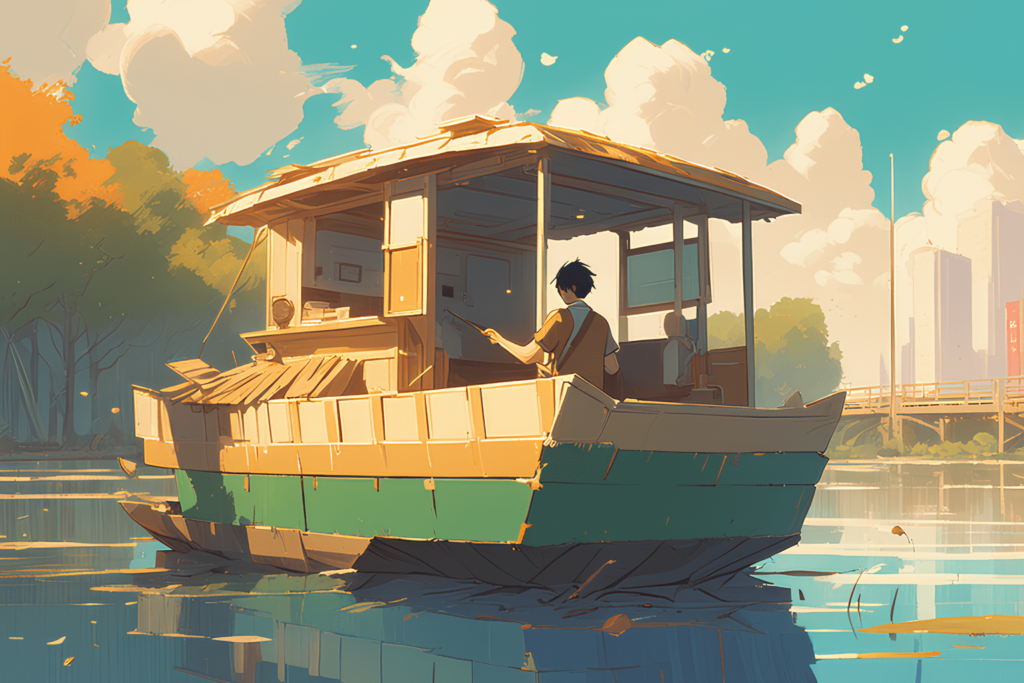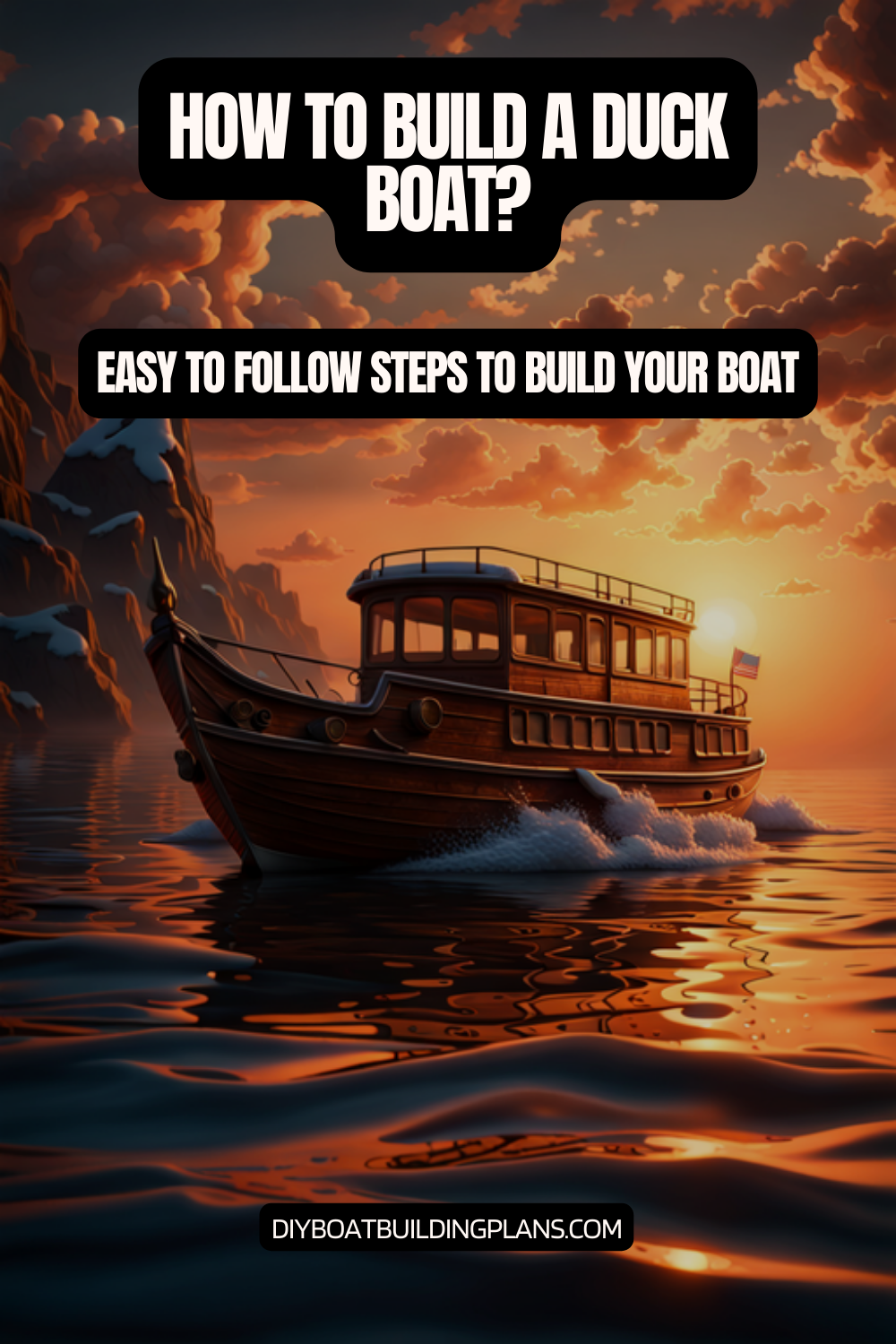Ever thought about saving money by making your own duck boat? DIY duck boat construction is a thrilling way for adventurous hunters to create a custom watercraft. It’s tailored to their hunting needs.
Using homemade duck boat plans can cut costs and offer a unique hunting experience. Building your own boat lets you customize everything. This includes size, design, and features for navigating backwaters and marshes.
Imagine turning raw materials into a reliable hunting platform for a fraction of the cost of commercial models. With some planning and basic woodworking skills, you can build a sturdy duck boat that fits your exact needs.
Key Takeaways – How To Build a Duck Boat
- DIY duck boat construction can save thousands of dollars
- Custom boats offer superior personalization compared to store-bought options
- Basic woodworking skills are sufficient for most boat-building projects
- Homemade duck boat plans provide flexibility in design and functionality
- Building your own boat increases understanding of watercraft mechanics

Introduction to Duck Boats
Duck hunting needs the right boat, and building your own is popular. It lets outdoor fans create a boat that fits their hunting style.
For waterfowl hunters, the right boat is key. It can turn a tough hunt into a success. Duck boat designs have improved, helping hunters tackle tough terrain.
What is a Duck Boat?
A duck boat is made for hunting waterfowl. These boats are:
- Lightweight and easy to move
- Great for shallow waters
- Camouflage helps hunters hide
- Strong against harsh weather
Benefits of Building Your Own
Building your own duck boat has big perks:
| Benefit | Description |
|---|---|
| Cost Savings | Materials cost about $500-$600 |
| Customization | Make it fit your hunting spot |
| Learning Experience | Learn to build and fix boats |
“Building your own duck boat isn’t just about saving money—it’s about creating a vessel that understands your hunting style.”
Pro tip: Think about your local hunting area when designing your boat. It will work better.
Materials Needed for Building a Duck Boat
Building a duck boat needs careful picking of materials and tools. Getting ready well ensures a strong watercraft for hunters. It will last for many years.
Making a duck boat needs precision and the right tools. Hunters and woodworkers must get the right tools and materials. This makes a reliable boat.
Essential Tools and Equipment
Every duck boat builder needs a wide range of tools. These tools are key for a successful build.
- Power Tools:
- Table saw
- Circular saw
- Jigsaw or bandsaw
- Screw gun
- Sander
- Hand Tools:
- Hand plane
- Tape measure
- Try square
- Clamps
- Chisels
- Japanese Ryoba saw
Recommended Wood Types
Picking the right wood is key for a strong boat. Southern Yellow Pine is a top choice for duck boats.
“Choose wood with straight grain and minimal knots for best results” – Professional Boat Builder
| Wood Type | Cost per 2x12x12′ | Durability Rating |
|---|---|---|
| Southern Yellow Pine | $15 | High |
| Marine Plywood | $25 | Very High |
Other Necessary Supplies
You’ll also need extra supplies for a good build:
- 5mm underlayment plywood ($11 per sheet)
- 3M 5200 marine adhesive
- Waterproof screws
- Safety equipment:
- Safety goggles
- Dust masks
- Protective gloves
Always put safety first. Get help from experienced woodworkers with special tools for your duck boat project.
Planning Your Duck Boat Design
Creating the perfect duck boat needs careful planning and smart design. Whether you’re an experienced hunter or just enjoy waterfowl hunting, knowing about duck boat design is key. It helps you build a boat that fits your hunting style.
Essential Design Considerations
Duck boat design is more than looks. Your boat must handle tough water and offer great hunting features. Important things to think about include:
- Water terrain compatibility
- Hunter and dog capacity
- Maneuverability in marsh environments
- Camouflage ability
Selecting the Right Boat Size
The size of your duck hunting boat is vital for both performance and comfort. Here are some size tips:
| Boat Length | Width | Recommended Use |
|---|---|---|
| 11-14 feet | 36-45 inches | Small rivers, limited access points |
| 14-16 feet | 48-54 inches | Open water, multiple hunters |
Drafting Your Blueprint
When designing your duck boat, precision is key. Use full-scale drawings to plan out important parts like stem pieces and cockpit areas. Good materials for making patterns include:
- Cardboard for initial sketches
- Thin plywood for detailed templates
- Long battens for drawing smooth curves
“A well-planned boat is half the battle in successful duck hunting.” – Professional Duck Hunter
Your duck boat is more than a way to get to the hunt. It’s your mobile hunting base. Spend time on good design to get the most out of your hunting trips.
Unlock the secrets to building your dream boat with MyBoatPlans! With detailed plans for over 518 boats and expert video tutorials, you’ll have everything you need to create your perfect vessel. Click here to begin your journey!
Step-by-Step Guide to Construct the Hull
Building a duck boat needs precision and careful attention. The steps for building the hull are key to making a strong and reliable boat for hunting.
First, gather all the necessary materials and tools. The process has many important stages. These stages will affect the boat’s performance and how long it lasts.
Preparing the Frame
Start with a solid base for your duck boat. The frame is the skeleton of the boat. It needs careful preparation:
- Select high-quality Southern Yellow Pine for frame components
- Create a sturdy form board as the initial structure
- Attach stem pieces carefully to establish the boat’s shape
- Ensure the center frame remains removable for flexible design
Assembling the Hull Components
Using precise techniques, assemble the boat’s parts. Important steps include:
- Install frames with careful measurement
- Add chines and bilge battens, notching frames as necessary
- Pre-bend long pieces like gunwales for easier installation
“Precision in hull construction determines the boat’s performance and durability.” – Experienced Boat Builder
Securing the Bottom and Sides
The final steps involve attaching the bottom and sides:
- Center bottom plywood, adding smaller pieces at each end
- Use 3M 5200 marine adhesive for strong connections
- Install side planks from the middle outwards
- Add reinforcement screws for extra stability
By carefully following these steps, you’ll make a sturdy duck boat. It will be ready for many hunting adventures.
Adding the Deck and Seating
Building the perfect duck boat needs focus on deck design and seats. The deck is key, shaping your hunting space. It affects both function and comfort.
- Maximize available space for gear and movement
- Ensure proper weight distribution
- Create concealment opportunities
- Allow easy access to hunting equipment
Deck Layout Strategies
A smart duck boat deck design turns your boat into a top-notch hunting spot. Add hidden storage and low-profile spots for camouflage. This makes hunting easier.
Creating Comfortable Hunting Seats
Seats for hunting must be comfy for long times outdoors. They should:
- Support well during movement
- Be ergonomic
- Hide quickly
- Resist the weather
Securing the Deck
Attaching the deck to the hull needs care. Use strong marine fasteners and seal it tight to avoid leaks. Add extra support where it’s needed for safety and durability.
“A well-designed duck boat is an investment in successful hunting experiences.” – Professional Duck Hunter
Pro tip: Always test your deck and seating before installing. This ensures they work best in real hunting situations.
Waterproofing Your Duck Boat
Building a duck boat needs careful waterproofing. This protects your vessel from water damage. It ensures your boat lasts long and works well in tough hunting spots.
Why Waterproofing Matters
Waterproofing your duck boat is key to avoiding wood rot and damage. It keeps your boat strong. Marine sealants help block water from getting in.
Top Marine Sealants for Protection
- 3M 5200 marine adhesive sealant
- Epoxy-based waterproofing compounds
- Polyurethane marine sealants
- Specialized marine-grade paint coatings
Effective Waterproofing Steps
- Clean and dry the boat surface thoroughly
- Sand rough areas for better sealant adhesion
- Apply marine sealants to seams and joints
- Use multiple thin coats for maximum protection
- Allow proper curing time between applications
| Sealant Type | Durability | Cost |
|---|---|---|
| 3M 5200 | Excellent | $20-$30 |
| Epoxy Coating | Very Good | $15-$25 |
| Polyurethane | Good | $10-$20 |
“Proper waterproofing is your boat’s first line of defense against harsh marine conditions.” – Professional Boat Builder
Pro tip: Pay extra attention to areas below the waterline and around moisture entry points. This ensures full protection.
Installing the Propulsion System
Choosing the right propulsion system is key for your duck boat’s performance. The motor selection and installation are vital for success.
When picking a motor for your duck boat, consider several important factors. These impact your boat’s efficiency and hunting skills.
Understanding Propulsion Options
Duck boats have different propulsion options. The main choices are:
- Longtail kits for duck boats
- Traditional outboard motors
- Electric trolling motors
Choosing the Right Motor
Choosing the right motor depends on several factors:
- Boat size and weight
- Water conditions
- Hunting environment
- Power requirements
*Pro Tip: For most duck boats, a 3-4 horsepower motor works best in shallow waters.*
Installation Safety Tips
Installing your duck boat motor needs careful attention. Follow these important tips:
- Ensure secure motor mounting
- Check weight distribution
- Verify steering accessibility
- Test electrical connections
Electric trolling motors have special benefits. Most offer about 0.8 horsepower. But, they shouldn’t run at full power all the time to avoid overheating.
Download over 500 Boat Plans. Click on the link below.
-->Click Here<--
Pro hunters suggest using deep-cycle batteries. Keep a 50% discharge cycle for the longest battery life.
Electronics and Navigation
Building a successful duck boat needs careful thought about electronics and navigation. The right duck boat electronics can change your hunting game. They offer safety, efficiency, and better visibility in early morning or late evening hunts.
Choosing the right navigation lights for hunting boats is key for safety and performance. Modern duck hunters know that advanced electronic systems can greatly improve their hunting success.
Basic Electronic Components
Every duck boat needs a full electronic setup. The main parts include:
- LED navigation lights
- Depth finder
- GPS unit
- Switches and control panels
Installing Lights and Navigation Aids
Putting lights in the right spots is vital for safety and visibility. You should install:
- 20-inch light bar for wide visibility
- LED strip lights for inside light
- Waterproof marine-grade switches
Battery and Power Management
Good power management keeps your electronics working all trip long. A dual-battery system gives you reliable power:
| Battery Purpose | Specifications | Power Consumption |
|---|---|---|
| Electronics Battery | 12V Marine Battery | ~7 Amperes |
| Motor Battery | Deep Cycle Marine Battery | Varies by Motor |
“Good electronics can mean the difference between a successful hunt and a frustrating day on the water.” – Experienced Duck Hunter
Pro tip: Always seal electrical connections to prevent water damage. Use quick-connect wiring for easy seasonal maintenance.
Customizing Your Duck Boat
Turning a basic duck boat into a hunting machine is exciting. It lets you show off your style and meet your needs. With duck boat camo painting and smart storage, your boat will look great and work well.
Painting and Finishing Options
Choosing the right camouflage for your duck boat is key. It’s not just about looks; it’s about blending in. Here are some painting ideas:
- Flat outdoor marine paints in natural earth tones
- Spray-on camouflage patterns mimicking local vegetation
- Hydro-turf sheets for non-slip surface texturing
Storage Solutions for Hunting Boats
Good storage for hunting boats makes your time on the water better. Well-designed compartments help you stay organized. They keep your gear within reach.
| Storage Type | Recommended Features |
|---|---|
| Gear Compartments | Waterproof, lockable, padded interior |
| Ammunition Storage | Sealed, moisture-resistant containers |
| Weapon Racks | Secure mounting, quick-access design |
Personalizing Aesthetics
Your duck boat should show off your hunting style. Think about adding custom decals, unique hardware, or personal touches. These make your boat special while keeping it useful.
A well-customized duck boat isn’t just a vessel – it’s a hunting companion that tells your unique story.
Safety Considerations for Duck Boats
Duck boat safety is key for any hunting trip. Hunters know that being ready can save lives on the water. With years of experience, experts stress the importance of safety gear and emergency plans.
Essential Safety Gear
Every duck boat needs important safety items for a safe hunt. Here are the must-haves:
- Bright orange life jackets for easy spotting
- Waterproof communication device
- First aid kit
- Emergency flares
- Floating throw bag
- Whistle or sound-producing device
Checklist for Safe Operation
Do a full safety check before you go:
- Check the hull for damage
- Test the motor
- Look at the weather
- Make sure all safety gear is there
- Have the right ways to communicate
Emergency Situation Preparedness
Being ready for emergencies is more than just having gear. Hunters say:
“No duck or goose is worth risking your life. Always prioritize personal safety over the hunt.”
| Emergency Scenario | Recommended Action |
|---|---|
| Man Overboard | Get them back in right away, use a flotation device |
| Sudden Weather Change | Head back to shore fast |
| Engine Failure | Use backup communication, signal for help |
Important safety tip: Always tell someone where you’re hunting and when you’ll be back.
Regular Maintenance for Longevity
Keeping your duck boat in good shape is key. It helps your wooden watercraft stay in top condition year after year. Regular care stops expensive fixes and makes your hunting boat last longer.
Wooden boat repair needs a careful plan. To keep your duck boat running well, focus on several important areas:
Essential Cleaning and Inspection Routines
- Use marine-grade cleaners to clean the boat after each trip
- Look for damage or wear on the hull
- Check electrical parts and battery terminals for rust
- Check wooden parts for rot or delamination
Critical Seasonal Maintenance Tasks
Seasonal care is vital for your duck boat’s health. Here’s how to do it right:
| Season | Maintenance Tasks |
|---|---|
| Spring | Full boat check, oil change, battery test |
| Summer | Regular cleaning, oiling moving parts |
| Fall | Get ready for winter, apply protective coating |
| Winter | Store indoors, check all equipment |
Addressing Common Repair Issues
Prevent big problems with regular care. Here are some repair tips:
- Fix small leaks or cracks right away
- Replace worn-out parts before they break
- Use marine-grade sealants on wood
- Keep electrical systems dry
“An ounce of prevention is worth a pound of cure” – this is true for duck boat care.
By following these repair tips, hunters can keep their duck boat reliable and safe. Regular maintenance is an investment that pays off in performance and longevity.

Conclusion and Next Steps
Building your own duck boat is more than a DIY project. It’s a journey into craftsmanship and outdoor passion. Your custom vessel is now ready to change your hunting experiences. It offers a unique platform tailored to your needs in the duck hunting community.
Connecting with fellow duck hunters is key after you finish your boat. Local hunting clubs and online DIY boat building resources are great places to share your creation. You can learn advanced techniques and grow your network.
Your journey doesn’t end with construction—it’s just starting. Keep learning and adapting. Look for workshops, hunting magazines, and online tutorials to improve your skills. Share your build process and modifications to inspire others.
Remember, each hunting season offers new chances to improve your boat. Your DIY duck boat is a living project that keeps getting better. Stay curious, keep your passion alive, and enjoy the unique experiences your handcrafted vessel will offer in the great outdoors.
FAQ – How To Build a Duck Boat
How much can I save by building my own duck boat?
Building your own duck boat can save you up to $5,000. This is because you choose the materials and do the work yourself. You avoid the extra costs that come with buying a pre-made boat.
What are the best wood types for building a duck boat?
Southern Yellow Pine is a top choice for duck boats. It’s strong, durable, and light. Plus, it resists water damage well.
What essential tools do I need to build a duck boat?
You’ll need power tools like a table saw and circular saw. Hand tools like chisels and hammers are also key. Don’t forget safety gear like goggles and dust masks.
What size duck boat is recommended for most hunting conditions?
A 14 feet long by 36 inches wide boat is best for small rivers. It’s easy to maneuver and fits 2-3 hunters and their gear.
How do I waterproof my homemade duck boat?
Use marine-grade sealants like 3M 5200 for the waterline. Apply marine-grade paint or varnish. Focus on seams and joints for full protection.
What type of motor works best for a duck boat?
Longtail kits or small outboard motors are good choices. A 459cc motor can reach 20 MPH in a 14-foot boat. The Backwater Inc. kit with a Predator motor is a great option for shallow water.
How important is camouflage for a duck boat?
Camouflage is very important for duck hunting boats. Use flat outdoor paint that matches your area. Hydro-turf sheets offer non-slip and camouflage benefits.
What safety gear should I include in my duck boat?
You’ll need life jackets, a first aid kit, flares, and a waterproof communication device. Always check safety before launching and tell someone your plans and when you’ll return.
How often should I maintain my duck boat?
Clean and inspect your boat after each use. Do seasonal maintenance like repainting and servicing the motor. Look for wear, focusing on high-stress areas and wood.
Can I customize my duck boat after building it?
Yes! Add storage, install a grab bar, and customize with decals or paint. You can also add electronics like lights and depth finders to meet your needs.



